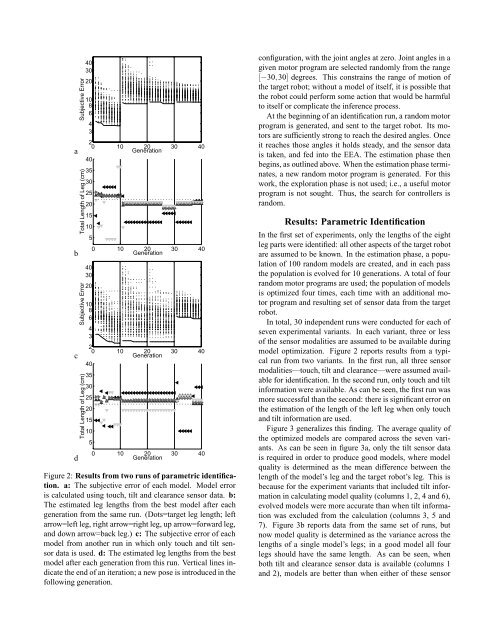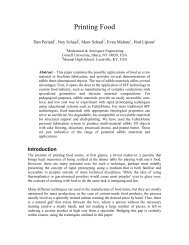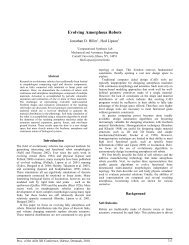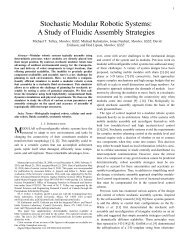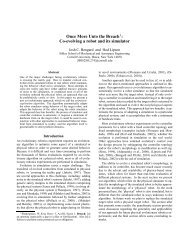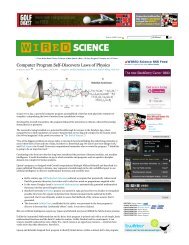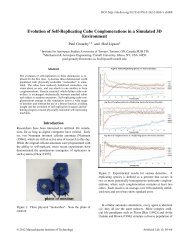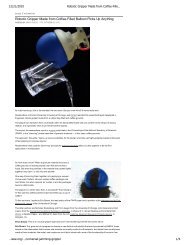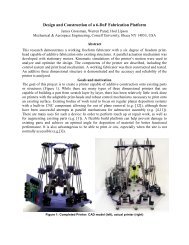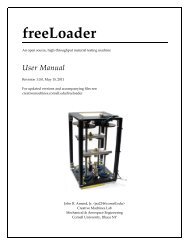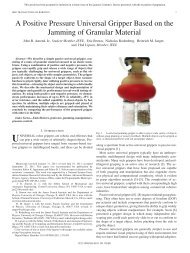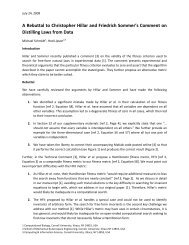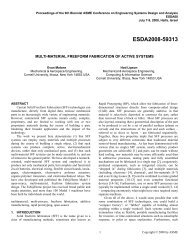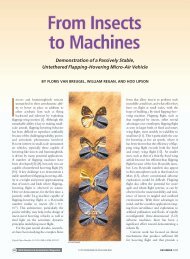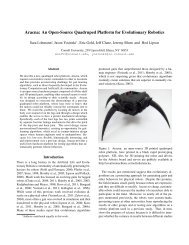Automated Synthesis of Body Schema using Multiple Sensor ...
Automated Synthesis of Body Schema using Multiple Sensor ...
Automated Synthesis of Body Schema using Multiple Sensor ...
Create successful ePaper yourself
Turn your PDF publications into a flip-book with our unique Google optimized e-Paper software.
a<br />
b<br />
c<br />
d<br />
Subjective Error<br />
Total Length <strong>of</strong> Leg (cm)<br />
Subjective Error<br />
Total Length <strong>of</strong> Leg (cm)<br />
40<br />
30<br />
20<br />
10<br />
8<br />
6<br />
4<br />
3<br />
2<br />
0<br />
40<br />
10 20<br />
Generation<br />
30 40<br />
35<br />
30<br />
25<br />
20<br />
15<br />
10<br />
5<br />
40<br />
30<br />
20<br />
10<br />
8<br />
6<br />
0 10 20 30 40<br />
Generation<br />
4<br />
3<br />
2<br />
0<br />
40<br />
10 20<br />
Generation<br />
30 40<br />
35<br />
30<br />
25<br />
20<br />
15<br />
10<br />
5<br />
0 10 20 30 40<br />
Generation<br />
Figure 2: Results from two runs <strong>of</strong> parametric identification.<br />
a: The subjective error <strong>of</strong> each model. Model error<br />
is calculated <strong>using</strong> touch, tilt and clearance sensor data. b:<br />
The estimated leg lengths from the best model after each<br />
generation from the same run. (Dots=target leg length; left<br />
arrow=left leg, right arrow=right leg, up arrow=forward leg,<br />
and down arrow=back leg.) c: The subjective error <strong>of</strong> each<br />
model from another run in which only touch and tilt sensor<br />
data is used. d: The estimated leg lengths from the best<br />
model after each generation from this run. Vertical lines indicate<br />
the end <strong>of</strong> an iteration; a new pose is introduced in the<br />
following generation.<br />
configuration, with the joint angles at zero. Joint angles in a<br />
given motor program are selected randomly from the range<br />
[−30,30] degrees. This constrains the range <strong>of</strong> motion <strong>of</strong><br />
the target robot; without a model <strong>of</strong> itself, it is possible that<br />
the robot could perform some action that would be harmful<br />
to itself or complicate the inference process.<br />
At the beginning <strong>of</strong> an identification run, a random motor<br />
program is generated, and sent to the target robot. Its motors<br />
are sufficiently strong to reach the desired angles. Once<br />
it reaches those angles it holds steady, and the sensor data<br />
is taken, and fed into the EEA. The estimation phase then<br />
begins, as outlined above. When the estimation phase terminates,<br />
a new random motor program is generated. For this<br />
work, the exploration phase is not used; i.e., a useful motor<br />
program is not sought. Thus, the search for controllers is<br />
random.<br />
Results: Parametric Identification<br />
In the first set <strong>of</strong> experiments, only the lengths <strong>of</strong> the eight<br />
leg parts were identified: all other aspects <strong>of</strong> the target robot<br />
are assumed to be known. In the estimation phase, a population<br />
<strong>of</strong> 100 random models are created, and in each pass<br />
the population is evolved for 10 generations. A total <strong>of</strong> four<br />
random motor programs are used; the population <strong>of</strong> models<br />
is optimized four times, each time with an additional motor<br />
program and resulting set <strong>of</strong> sensor data from the target<br />
robot.<br />
In total, 30 independent runs were conducted for each <strong>of</strong><br />
seven experimental variants. In each variant, three or less<br />
<strong>of</strong> the sensor modalities are assumed to be available during<br />
model optimization. Figure 2 reports results from a typical<br />
run from two variants. In the first run, all three sensor<br />
modalities—touch, tilt and clearance—were assumed available<br />
for identification. In the second run, only touch and tilt<br />
information were available. As can be seen, the first run was<br />
more successful than the second: there is significant error on<br />
the estimation <strong>of</strong> the length <strong>of</strong> the left leg when only touch<br />
and tilt information are used.<br />
Figure 3 generalizes this finding. The average quality <strong>of</strong><br />
the optimized models are compared across the seven variants.<br />
As can be seen in figure 3a, only the tilt sensor data<br />
is required in order to produce good models, where model<br />
quality is determined as the mean difference between the<br />
length <strong>of</strong> the model’s leg and the target robot’s leg. This is<br />
because for the experiment variants that included tilt information<br />
in calculating model quality (columns 1, 2, 4 and 6),<br />
evolved models were more accurate than when tilt information<br />
was excluded from the calculation (columns 3, 5 and<br />
7). Figure 3b reports data from the same set <strong>of</strong> runs, but<br />
now model quality is determined as the variance across the<br />
lengths <strong>of</strong> a single model’s legs; in a good model all four<br />
legs should have the same length. As can be seen, when<br />
both tilt and clearance sensor data is available (columns 1<br />
and 2), models are better than when either <strong>of</strong> these sensor


